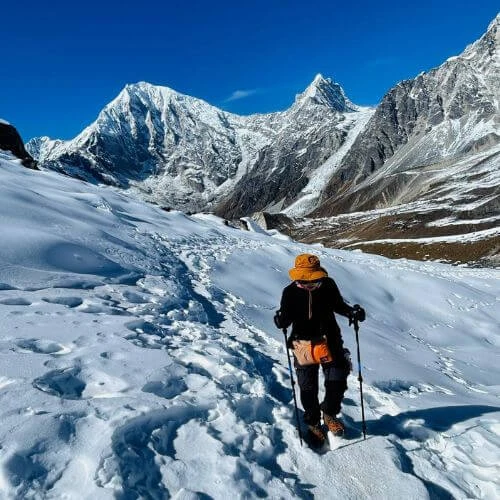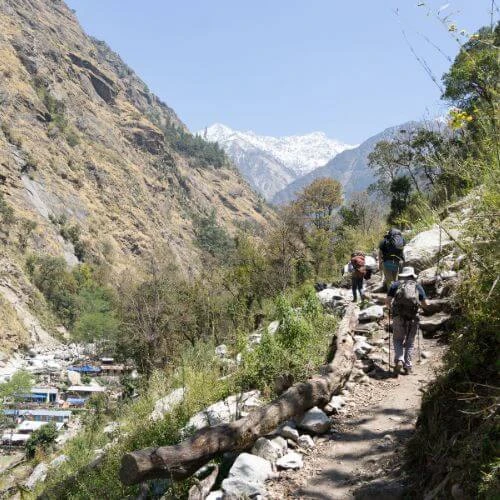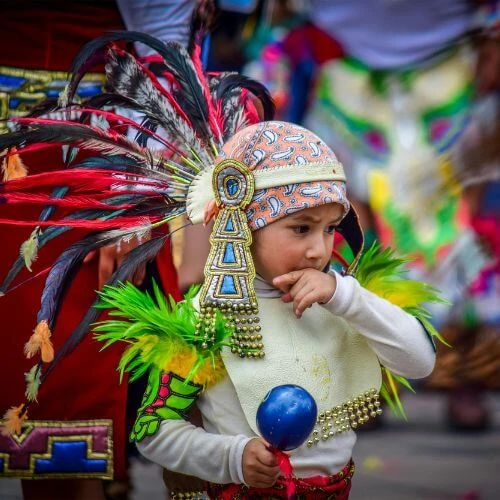Best Time to Trek to Annapurna Base Camp
Spring ( Late March - Late May )
Spring today covers the period from late March to late May and has become one of the best times for trekking to Annapurna Base Camp due to a shift in weather patterns because of climate change.
The clarity and stability of the weather are considered some of the major reasons for the Annapurna base camp trekking in spring. The sky is mostly open, creating breathtaking views of mountains and landscapes. The mild temperature of Spring keeps trekking pleasant during the day and relaxed at night, unlike the freezing cold of winter or wet monsoon seasons. Late March can be still snowy higher up, which adds a little adventure to the trek.

The Annapurna region looks more beautiful in spring as the rhododendron flowers bloom. Red, pink, and white flowers are in traces on both forests and hills, making the environment a pleasant sight to behold. The clear visibility of the Himalayas in the backdrop adds charm to this season, thus making April and May favorable seasons for trekkers.
Since spring is peak trekking season, the trails are well-maintained, and teahouses are open to providing food and accommodation. However, the popularity of this season means the trails can be busier, especially in April. It's a good idea to book your accommodation ahead of time.
Autumn ( Late September - Late November)
While spring remains the best season for trekking to Annapurna Base Camp (ABC), autumn, from late September to late November, is the second-best time to trek to the Annapurna Base Camp. Climate change has slightly shifted autumn's characteristics, but it still offers a highly appealing trekking experience with beautiful views and pleasant weather.
Autumn weather has changed over time. Late September, which used to mark the end of the monsoon, sometimes still brings lingering rain. However, October has become a great month for trekking, offering stable weather and clear skies, making it the best time to trek in autumn, just behind spring. By November, the colder temperatures arrive earlier, signaling winter’s approach. Despite these changes, Annapurna Base Camp Trek in autumn offers favorable conditions, though it’s not quite as ideal as the warmth and clarity of spring.

Visibility during the autumn season remains good, especially in October and early November. While the skies aren’t always as crystal-clear as they are in spring, the mountain views are still stunning. October offers some of the best panoramic views of the Annapurna range, ranking just behind the sharp visibility of spring. The occasional haze from forest fires might appear, but overall, autumn is a great time to soak in the breathtaking scenery.
Trekking conditions in autumn are generally dry and stable after the monsoon. The landscapes remain lush from the rains, and in late October and November, the forests show beautiful fall colors, offering a different experience from spring’s blossoms. The cultural richness of the season adds to the experience, with local festivals like Dashain and Tihar taking place along the trekking routes.
Interestingly, early December, though technically part of winter, is becoming one of the best times to trek in Annapurna Base Camp despite autumn due to climate change. Early December might not be as ideal as spring or October, but it offers a peaceful and still rewarding trekking experience. The colder temperatures might be a challenge, but with proper preparation, this period provides solitude and breathtaking views, making it a good option when spring or peak autumn dates aren’t available.
Understanding the Annapurna Basecamp Trek weather conditions
January
January is the coldest month in Nepal, and due to climate change, winters have become drier with less snowfall. Snowfall has shifted to February and March, making January a great time to visit Annapurna Base Camp (ABC). Minimum temperatures vary between 2°C and 5°C, while maximum temperatures range around 12°C to 15°C, keeping a mean temperature of 8°C in lower altitudes. Meanwhile, the temperatures may be lower at higher altitudes, as low as 13°C.
Visibility is clear up to 5 km; therefore, even though there isn't any snow in the lower elevations, it can still be seen in the higher altitudes. The skies are clear, and the mountain scenery is spectacular for trekking. Nonetheless, pack some warm clothes, as it still gets cold at night and the Annapurna Base Camp weather can change suddenly.
February
Due to climate change, February, which used to be the heart of winter in Nepal, now falls in the late winter period. Heavy snowfall can be expected on the ABC trek during February. Temperatures at lower altitudes range from a minimum of 4°C to 7°C, the highest between 14°C and 17°C, and an average of 10°C. In higher altitudes, the temperature may fall to as low as -12°C.

Although February still looks very beautiful in its winter landscape, the trekkers need to be completely prepared for the chilled weather, as sometimes the trails may be closed. The visibility often remains poor, so caution must be exercised with readiness for sudden changes in weather at every turn.
March
March traditionally marked the beginning of spring, but due to climate change, it now feels more like early spring, with chances of snowfall at higher altitudes. This month also marks the start of the peak trekking season, though the weather remains unpredictable.
In lower altitudes, temperatures range from a minimum of 6°C to 9°C, a maximum of 17°C to 20°C, with an average of around 13°C. However, at higher altitudes, temperatures can drop as low as -14°C.
While the season is generally dry, 2024 saw an unusual number of forest fires, which led to poor visibility and thick haze. Keep in mind that conditions can vary each year.
April
Due to climate change, spring in Nepal has now extended into April, making it the main spring season and the best month for the abc trek. During this period, temperatures are mild, featuring warm days and cool nights. The breathtaking views of the mountains enhance the trekking experience, and rhododendrons begin to bloom in this season instead of March.
In lower altitudes, temperatures typically range from a minimum of 5°C to 8°C and a maximum of 15°C to 18°C, with an average of around 12°C. In contrast, higher altitudes can experience minimum temperatures as low as -5°C.

This beautiful season attracts many trekkers and nature enthusiasts, eager to explore the stunning trails of the Himalayas and enjoy the stunning landscapes.
May
Until recently, May was considered as a spring month however, these days, it's more like late spring. Trekkers can witness the rhododendrons that start blooming around this season, along with clear skies. The daytime temperature might rise to 18°C (64°F), while the night temperature falls to 3°C (37°F) in the Annapurna Base Camp. Lower altitudes have a mild temperature, around 10°C (50°F); however, the higher altitudes might have as low as -1°C. The time is best to trek to Annapurna Base Camp for the breathtaking mountain views, with the temperatures still at their moderate pace and beautiful rhododendron blooms.
June
Lately, the monsoon in Nepal have shifted towards the end of June while previously it wasin the early June. Such circumstances have made treks in September less appealing since it used to be the peak trekking season in Nepal. June now indicates the beginning of the early monsoon that has come a bit late than previously experienced.
However, many hikers can still have enjoy trekking during this season as long as they are prepared for light showers from time to time. During the Annapurna Base Camp Trek in June, the general temperature at lower altitudes is from 20°C to 5°C during night time, while the day temperature is mild around 12°C. In higher altitude ranges, the temperatures drop from 0 to 5°C.
It is usually good weather in July, with clear skies and warm days, ideal for a long hike. Overall, July remains one of the best months to hike to Annapurna Base Camp.

July
July is the peak of the monsoon season in Nepal, bringing heavy rains that make Annapurna base camp Trek difficult. The monsoon now starts earlier, with rainfall beginning in late June and reaching its peak in July. This extreme weather often leads to floods, landslides, and even droughts in remote areas, making popular trekking routes unsafe.
Frequent downpours and unstable trail conditions cause major disruptions, making trekking in popular regions unfavorable. For a safer option, rain-shadow areas like Upper Mustang and Dolpo are ideal. These areas receive little rain and remain accessible during the monsoon.
However, If you still plan to trek to Annapurna Base Camp, be prepared for varying temperatures. In lower altitudes, daytime temperatures can reach 21°C (70°F) and drop to 7°C (45°F) at night. Mild temperatures around 14°C (57°F) are common, but in higher altitudes, it can go as low as 6°C. Proper preparation is essential for a safe trek in these conditions.
August
August now is still part of the monsoon season in Nepal, with occasional heavy rain. Instead of ending, the monsoon now often continues into early September, which is unusual.
During this month, temperatures on the Annapurna Base Camp (ABC) trek go up to 21°C (70°F) during the day and drop to 7°C (45°F) at night, with mild temperatures around 14°C (57°F) in lower areas. In higher areas, nighttime temperatures can drop to 5°C.
Trekking is usually not recommended in August because of the rain and the risk of landslides, which can make trails unsafe. It's important not to trek alone without a guide, as it can be hard to navigate these conditions. Choosing a guided trek helps ensure safety and offers local knowledge, making the experience better overall.

September
September used to be the best time for trekking in Nepal because it marked the start of autumn. However, with the monsoon shifting forward, trekking in early September has become less ideal. Heavy rains have caused landslides and floods, damaging roads and trails, and making it difficult for trekkers. The extended monsoon also brings unpredictable weather, making it less favorable for trekking.
That said, as the monsoon ends by late September, conditions improve. Trails dry up, and trekking becomes more favorable with stunning landscapes after the rainfall. In the Annapurna Base Camp (ABC) trek, the temperature at lower altitudes ranges from -1°C to 2°C at night and 9°C to 14°C during the day, with an average of around 6°C. At higher altitudes, temperatures can drop to 2°C or lower, so trekkers should be prepared for colder conditions.
October
October is widely recognized as the best time to trek in Annapurna base camp as well as in Nepal, especially in recent years. October month marks the beginning of the autumn season, bringing mild and clear weather that showcases stunning landscapes. Major festivals, such as Dashain and Tihar, often take place in October, adding a unique cultural experience to the trek. Trekkers can enjoy local celebrations and festivities along the way.
In the lower regions of the Annapurna Base Camp (ABC) trek in October, temperatures typically range from a high of 18°C to a low of 6°C, with a mean temperature of around 12°C. At higher altitudes, temperatures can drop to -7°C, so trekkers should be prepared for colder conditions.
With the monsoon rains now behind, the views of the Annapurna mountain range are breathtaking. The excellent visibility allows trekkers to enjoy stunning sunrises and sunsets, making October an ideal time to trek to Annapurna Base Camp.

November
November, once a part of autumn, has now begun to show signs of early winter. Despite the colder temperatures, it remains one of the best times to trek to Annapurna Base Camp. You can enjoy clear views, as clouds and fog rarely obstruct the scenery.
However, it's important to be prepared for the drop in temperature, especially at higher elevations. In lower altitudes, the temperature ranges from a high of 20°C (68°F) to a low of 5°C (41°F), with an average of around 12.5°C (54.5°F). In higher altitudes, the nights can get as cold as -11°C (12.2°F).
This season offers ideal trekking conditions across Nepal, allowing trekkers to experience breathtaking views and pleasant weather.
December
December, once known for its harsh winter cold, has now become drier, offering chilly but clearer skies and being among the abc trek's best times. Fewer trekkers are aware of this change, so the trails are less crowded. While the cold presents a challenge, the stunning views make it well worth it. Snowfall, which used to arrive in December, now typically comes in January.
During the Annapurna Base Camp trek, temperatures at lower altitudes range from a high of 16°C (60.8°F) to a low of 0°C (32°F), with an average of around 8°C (46.4°F). At higher altitudes, nighttime temperatures can drop to as low as -14°C (6.8°F). Despite the cold, the beauty of the trek in December is unmatched.

Conclusion
Weather conditions are a crucial factor in determining the best time to trek to Annapurna Base Camp. It is considered one of the most popular treks in Nepal, mainly because of its rich biodiversity. People usually trek during specific seasons of the year, but with the changes brought by global warming, these seasons are slowly changing. Understanding the Annapurna Base Camp weather by season can enable trekkers to make better decisions. A combination of factors such as temperature, visibility, and conditions of the trails throughout the year proves useful in enabling trekkers to choose the time that suits them and their capacities. Each season has its benefits, be it flowers in bloom, clear mountain views, or less crowded on the trails. With proper planning and preparation, though, it's possible to have an excellent trek to Annapurna Base Camp in any season.
Frequently asked questions
1. Is it safe to trek to Annapurna Base Camp in winter?
Trekking to Annapurna Base Camp in winter can be quite challenging due to heavy snowfall and cold temperatures. If you’re well-prepared, have the right gear, and have some experience with winter trekking, you can enjoy the trek safely.
2. What is the best season for clear mountain views at ABC?
For the clearest mountain views at Annapurna Base Camp, you can plan your trek during the spring (March to May) or autumn (September to November). During these seasons, the weather tends to be stable, giving you excellent visibility.
3. When should I avoid trekking to Annapurna Base Camp?
It’s best to avoid trekking to Annapurna Base Camp during the monsoon season (late June to early September) because the heavy rains can lead to landslides and make the trails unsafe.
4. Do I need a guide for the Annapurna Base Camp trek?
Yes, as of April 1, 2023, all foreign trekkers are required to hire a guide for the Annapurna Base Camp trek. This rule ensures better safety and support along the trail.
5. Are teahouses open year-round at Annapurna Base Camp?
Teahouses at Annapurna Base Camp generally stay open year-round, though their availability can be limited during the winter months when fewer trekkers visit the area.
6. When can I see rhododendrons blooming in the Annapurna region?
You can witness the stunning rhododendrons blooming in the Annapurna region from late March to early April, filling the landscape with vibrant colors.
7. Which month has the least crowds on the ABC trek?
If you prefer a quieter trek, consider going in February, as this month usually sees the least crowds at Annapurna Base Camp due to the colder weather.



 based on 5 reviews
based on 5 reviews










